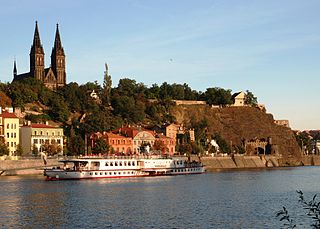Self-guided Sightseeing Tour #10 in Prague, Czechia
Legend
Tour Facts
6.2 km
201 m
Experience Prague in Czechia in a whole new way with our self-guided sightseeing tour. This site not only offers you practical information and insider tips, but also a rich variety of activities and sights you shouldn't miss. Whether you love art and culture, want to explore historical sites or simply want to experience the vibrant atmosphere of a lively city - you'll find everything you need for your personal adventure here.
Activities in PragueIndividual Sights in PragueSight 1: Divadlo Na Fidlovačce
Divadlo na Fidlovačce is a private theatre based in Prague.
Sight 2: Kaple svaté Rodiny
The Chapel of the Holy Family is located in Prague's Vinohrady district in Pod Nuselským schody Street. It was founded in 1755 by the Prague burgher and municipal councillor Karel Leopold Bepta, who also bequeathed his property to it as a vineyard chapel on the land of the homestead later called Vondračka. Bepta had the chapel founded here allegedly because the people working on his land were "a mischievous and very unrestrained bunch" and the opportunity to attend services in the chapel was supposed to help them get back on the right track.
Sight 3: Bohyně 390 km v hodině
The Goddess 390 km per hour was a statue located on the Charles bridgehead near the Nusle Bridge in New Town in Prague 2.
Sight 4: Panna Maria a svatý Karel Veliký
The Church of the Assumption of the Virgin Mary and St. Charles the Great is located in the Karlov area of Prague. The originally Gothic church was rebuilt and augmented in baroque style. The church is a part of the former convent of the Augustinian Order in Prague's Karlov.
Wikipedia: Church of the Assumption of the Virgin Mary and St. Charles the Great, Prague (EN), Heritage Website
Sight 5: Z vlastního rozhodnutí
By Your Own Decision – Memento mori is a monument in Prague's Folimanka Park, which is dedicated to the memory of people who voluntarily ended their lives by jumping off the Nusle Bridge. The monument was designed and created by sculptor Krištof Kintera. It consists of a ten-meter-high street lamp, the light of which is directed upwards towards the bridge. On the lamp pole, at about the level of human eyes, there is a sign with the inscription "Memento mori – to those who took their own lives in these places of their own accord." Originally, the number of people who died under the bridge was supposed to be listed on the sign, but because the exact number is unknown, this plan was abandoned.
Sight 6: Prague Congress Centre
Prague Congress Centre, originally Palace of culture Prague, is a large neofunctionalist building in Czech Republic capital Prague 4 district Nusle, located on the edge of Nusle Valley, near to the Nusle Bridge and Prague Metro C station Vyšehrad. There are 70 halls, lounges and meeting rooms of various sizes in this building, with total capacity of 9,300 people.
Sight 7: Táborská brána
The Tábor Gate is a late Renaissance gate in Prague's Vyšehrad district. It is located in the south-eastern part of the Vyšehrad advanced fortification. The gate is entered from the southeast, from Nusle, or Pankrác, from V pevnosti Street, which is connected to Na Pankráci Street.
Sight 8: svatý Michal
The Church of St. Michael the Archangel in Podolí is a Roman Catholic parish church, originally a late Romanesque building from the beginning of the 13th century with a wooden Baroque bell tower standing nearby. It acquired its pseudo-Romanesque appearance at the end of the 19th century. It is located in Pod Vyšehradem Street in Prague 4-Podolí.
Sight 9: The Remains of the Gothic Špička (Peak) Gate
The Špička Gate is a fragment of a preserved Gothic gate, which is located in the former fortifications of Prague's Vyšehrad.
Sight 10: Saint Martin
The Rotunda of St. Martin is located at Vyšehrad and is the oldest preserved rotunda in Prague. Since its construction to the present day, the building has undergone many changes, both architecturally and in the way it is used. The rotunda was built in the Romanesque style, and thanks to later reconstructions, this style was preserved through re-Romanization. The current owner is the Vyšehrad Chapter, masses are regularly held in the rotunda and it is possible to look inside by appointment.
Sight 11: The Leopold Gate
Leopold's Gate is an early Baroque gate in Prague's Vyšehrad district. It is located in V pevnosti Street, it is part of the Vyšehrad citadel. The gate was built between 1653 and 1672, the exact year of the start and completion of the construction is unknown. It was probably created according to the architectural design of Carlo Lurago, whose drawing of the building has been preserved. Leopold's Gate forms the entrance to the inner Vyšehrad fortress. Although it was part of a fortification system designed by architect Giuseppe Priami, it never served a military purpose. It has been used functionally since the middle of the 19th century, when a road between the New Town and Pankrác was built through Vyšehrad.
Sight 12: Saint Procopius
The Statue of Saint Procopius is installed in a niche of the wall of the homestead K rotundě 16/3 at Vyšehrad, Prague, Czech Republic.
Sight 13: Monument to Provost M. Karlach

Vyšehrad is a historic fort in Prague, Czech Republic, just over 3 km southeast of Prague Castle, on the east bank of the Vltava River. It was probably built in the 10th century. Inside the fort are the Basilica of St. Peter and St. Paul and the Vyšehrad Cemetery, containing the remains of many famous Czechs, such as Antonín Dvořák, Bedřich Smetana, Karel Čapek, and Alphonse Mucha. It also contains Prague's oldest Rotunda of St. Martin, from the 11th century.
Sight 14: Saint John of Nepomuk
The statue of John of Nepomuk is installed at Vyšehrad in Prague, Czech Republic.
Sight 15: The Devil's Pillar
Devil's Column is a formation of three stone columns, located in Vyšehrad, Prague, Czech Republic.
Sight 16: Slavín
Slavín is a tomb at the Vyšehrad Cemetery in Prague. Many notable Czech personalities are interred in the tomb.
Sight 17: Gorlice
Gorlice is an underground hall in casemates inside the walls of Prague's Vyšehrad. It is located in the northeastern, 33rd bastion, to the east of the Brick Gate. The hall is vaulted with a barrel vault 13 meters high and has an area of about 330 m². Originally, it served as a gathering place for troops and a warehouse for supplies and ammunition. Gorlice was opened to the public after reconstruction in the 1990s. The space is used for exhibitions and theater performances.
Sight 18: Brick Gate
The Brick Gate, also known as the New Gate, is an Empire gate in Prague's Vyšehrad district. It is located in the northern part of the Vyšehrad fortifications and provides access to the citadel from the north, from the New Town. From the New Town, there is access to the gate from Vratislavova Street, which is connected to V Pevnosti Street at Vyšehrad.
Sight 19: Saint Wenceslaus I, Duke of Bohemia
The statue of Saint Wenceslas is an outdoor sculpture by Johann-Georg Bendl from 1680, installed at Vyšehrad, Prague, Czech Republic. The statue formerly stood in the middle of Wenceslas Square, near Grandhotel Evropa, but was moved to Vyšehrad in 1879.
Sight 20: Václav Štulc
The bust of Václav Štulc is installed at Štulcovy sady in Vyšehrad, Prague, Czech Republic.
Sight 21: Saint Peter and Saint Paul
The Basilica of St. Peter and St. Paul is a neo-Gothic collegiate and parish church in Vyšehrad fortress in Prague, Czech Republic.
Wikipedia: Basilica of St. Peter and St. Paul, Prague (EN), Heritage Website
Sight 22: Saint Sebastian
The statue of Saint Sebastian is installed at Vyšehrad, Prague, Czech Republic.
Share
Disclaimer Please be aware of your surroundings and do not enter private property. We are not liable for any damages that occur during the tours.
GPX-Download For navigation apps and GPS devices you can download the tour as a GPX file.








-Gate.jpg)











